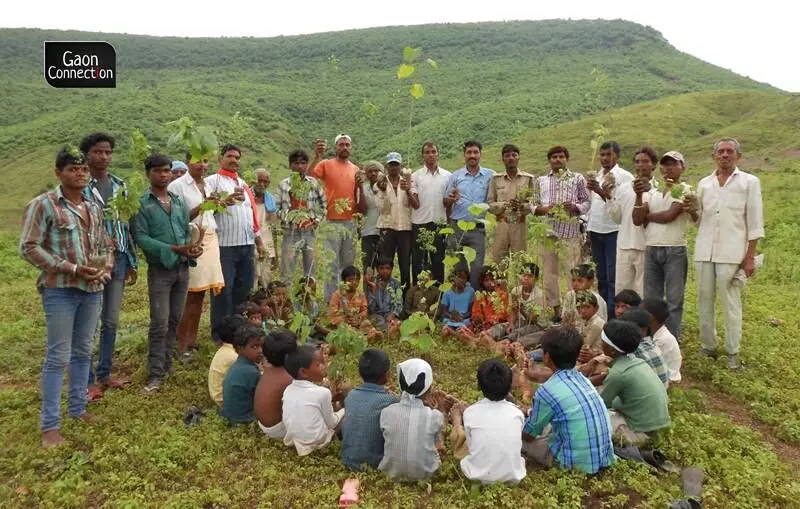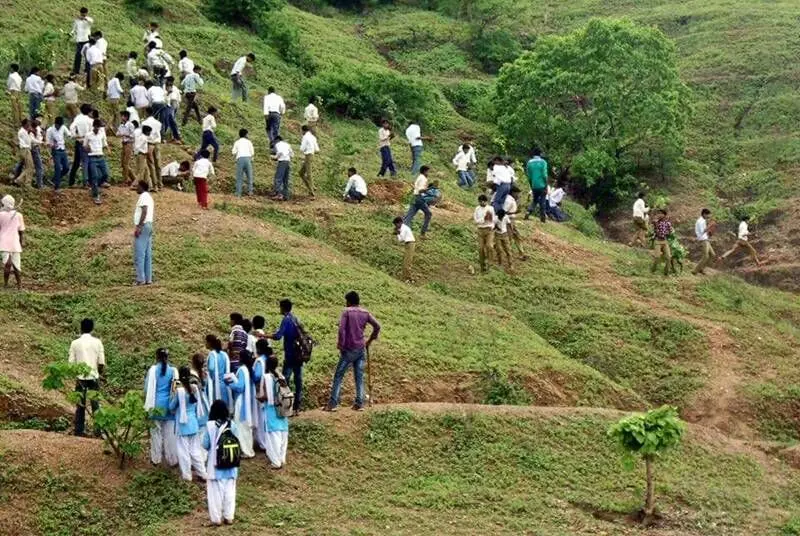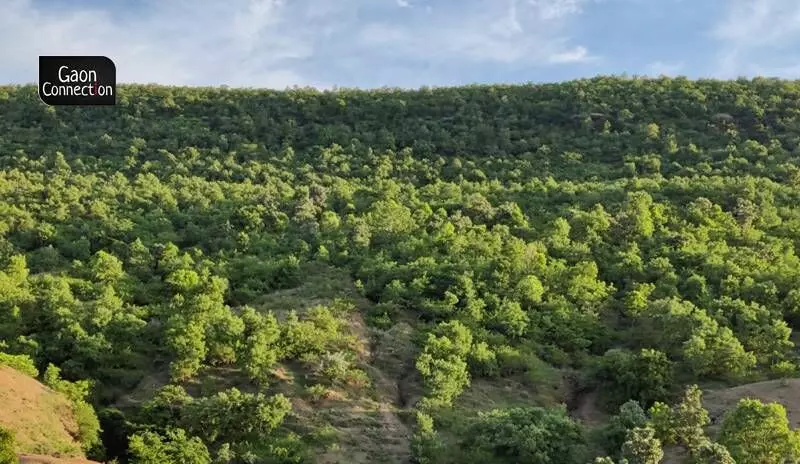Patna Tamoli (Panna), Madhya Pradesh
The sounds of axes have fallen silent. And no cattle is allowed to graze there. Because of this, the once bone dry, scarred and ravaged landscape of a hill in Patna Tamoli village in Panna district, has begun to breathe again.
The village, which lies about 60 kilometres from the district headquarters of Panna, is in the news for its people-driven initiative of re-greening 142 hectares of barren hill slopes that over a span of 15 years is home to a forest.
“Currently, there are trees that are between 20 to 30 feet in height. While some of the trees including the neem tree and night jasmine have come up naturally, teak saplings have been planted there too,” Setubandhu Chaurasiya, a retired teacher from Patna Tamoli told Gaon Connection. He played a lead role in getting the villages together to regrow forest on their hill slopes.
“Only some dead stumps of trees remained and even roots of wild shrubs were not spared. Everything was uprooted to be used as firewood,” Setubandhu said. “Because there was no kind of vegetation on the hill, every time it rained, the water washed away the soil,” the 70-year-old added.

Today, not only people from the neighbouring villages and towns, but even forest officials applaud the work done by the villagers.
This also led to the depletion of the groundwater in the village that has a population of about 5,000.
Seeds of change
Setubandhu Chaurasiya was always interested in the environment and led a team of local people who worked on the environment protection team. “Wherever we found the space, we began to plant saplings, and in 2004, our attention was drawn to Patna Tamolivillage,” Setubandhu recalled.
The degraded hillside, with not even a blade of grass to add green to it, was in dire need of help. “We decided to work there and got in touch with the village inhabitants. However, at that time they were not interested in greening the area,” the retired school teacher said.
But, the idea of greening the hillsides appealed to some of the younger people in the village. “Ajay Chaurasiya was one of them who then gathered around the other youth from the area and the idea began to gather momentum,” Sethubandhu said.

The village, which lies about 60 kilometres from the district headquarters of Panna, is in the news for its people-driven initiative of re-greening 142 hectares of barren hill slopes that over a span of 15 years is home to a forest.
Not just Patna Tamoli, even the neighbouring villages began to show interest and gradually, people stopped uprooting vegetation on the hillside and did not let their cattle graze there either. In the space of a few years, undisturbed by human activity, a carpet of green began to grow on the slopes, and trees began to reappear.
Also Read: In a first, radio tags help trace migratory routes of Himalayan Griffon vultures
“In 2005, the hillside was bereft of any sign of green,” recalled Pramod Varma, one of the young people who became part of the greening movement.
According to Varma, with the encouragement and drive of Setubandhu, the young men of the village including himself, Ajay Chaurasiya, Om Soni, Brindavan Chaurasiya, Krishna Kumar Panda and Harinarayan, formed a team and set to work.
“In the beginning we did not allow any vegetation on the hillside to be disturbed and soon new shoots began to appear on the stumps of the felled trees. In only three to four years, a blanket of green covered the slopes, and now we have a jungle standing there,” a proud Varma told Gaon Connection.
As a result, in the past fifteen years or so, the once degraded hillsides in Patna Tamoli, spread over 142 hectares, are now home to a variety of flora and fauna.
Patna Tamoli, a green ‘pilgrimage’
Today, not only people from the neighbouring villages and towns, but even forest officials applaud the work done by the villagers.
Chittaranjan Tyagi, additional principal chief conservator of forests of Madhya Pradesh, visited Patna Tamoli village on November 21 last year, and he was impressed. “It is like a pilgrimage centre for me. It just goes to prove that if people make up their minds, miracles can be wrought,” Tyagi told Gaon Connection.
Uttam Kumar Sharma, field operator of Panna Tiger Reserve and Gaurav Sharma, the DFO (divisional forest officer), visited Patna Tamoli too.
Redeeming the village
Incidentally, twenty years ago, Patna Tamoli had figured in the news reports, for a very different reason. It was in this village that a 65-year-old woman, Kattubai was burnt alive on the pyre of her husband in August 2002.
The state Chief Minister Digvijay Singh took action against the village by denying any government support to it for two years. The sati (widow burning) incident was a blot on the village.
The greening initiative has somewhat redeemed the village, say the villagers. Not only has it changed the face of the village, but now the village is upheld as an example of how greening can be done.
Ajay Chaurasiya who contributed significantly to the greening effort, deeply regretted how the environment was being defiled at every opportunity in the name of progress. “Despite so many rules and regulations, illegal mining, tree felling and exploitation of groundwater is rampant. Rivers are being depleted with borewells tearing through the river beds and not just trees, entire jungles are being felled,” the 45-year-old lamented.

Not just Patna Tamoli, even the neighbouring villages began to show interest and gradually, people stopped uprooting vegetation on the hillside and did not let their cattle graze there either. In the space of a few years, undisturbed by human activity, a carpet of green began to grow on the slopes, and trees began to reappear.
“While the people are facing the consequences in the form of droughts and floods, they still do not recognise the fact that these are warnings from Nature,” he told Gaon Connection. “We are ignoring the signs and this will be a costly mistake,” he added. It was just as well that Patna Tamoli woke up in time, read the signs and decided to take corrective measures, he said.
“It is not just the green hillsides that are a cause of celebration for us. The new forests are home to many many species of birds and several migratory species also visit us now,” said Setubandhu with considerable pride.


















